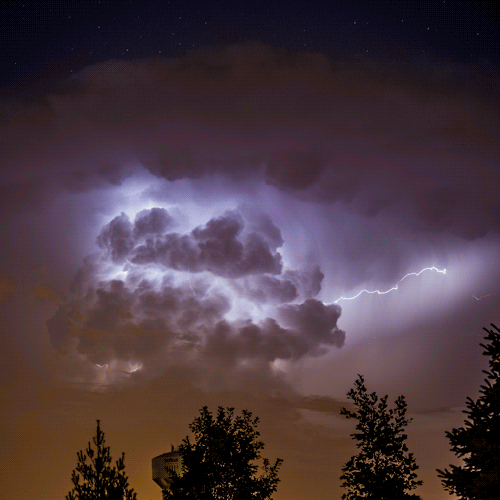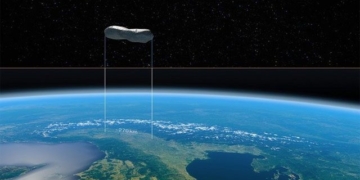According to scientists, compared to light traveling at speeds up to 300,000 km/second, sound waves are extremely slow in the air, moving at only 0.3 km/second. This is also the reason why we often see lightning before hearing thunder.
So, the question arises: what would happen if the speed of sound suddenly increased a million times, reaching the speed of light?
In such a scenario, we would naturally see both the lightning and hear the thunder at the same time. However, the appearance of the lightning would be quite strange, creating areas of higher and lower density within the wave.

If sound traveled at the speed of light, we would witness both the lightning and hear the thunder simultaneously. (Image: Pinterest)
For example, think of a rainbow spring as an illustration. Specifically, when this spring moves, the coils continuously compress and then expand. Sound waves behave similarly. At a slow speed, the changes in density are imperceptible. However, at light speed, it becomes a very different story.
According to Professor of Physics George Gollin at the University of Illinois at Urbana-Champaign, during a thunderstorm, the air becomes very humid. As sound waves pass through, they compress everything and then spread out, causing a significant drop in pressure. Since pressure corresponds to temperature, the sudden drop in air pressure after the thunder would freeze the humid air. Consequently, we would see lightning piercing through a dense fog of ice crystals.
Extreme speeds would completely alter the sound landscape of our world. Professor Gollin explains that, for example, the human voice would reach such high frequencies that it would become inaudible, sounding very unusual.
If sound traveled faster in the air, it would change how waves combine. This would amplify some frequencies while quieting others. In sound waves, an increase in frequency leads to a rise in pitch, making human voices sound quite bizarre.
To imagine how humans would sound in an environment where sound travels extremely fast, picture how your voice would sound after inhaling helium gas.
Professor William Robertson, a researcher in the Department of Physics and Astronomy at Middle Tennessee State University, states that inhaling helium makes a person’s voice resemble that of a cartoon character. The reason is that sound waves travel three times faster through pure helium. If sound could travel at a million times that speed, the results would be even more remarkable.
Sudden Acceleration of Sound and Unexpected Changes?
Professor Robertson further explains that if the speed of sound suddenly increased, it would devastate orchestras. In reality, wind instruments function similarly to the vocal cords of humans. Specifically, when sound moves back and forth inside the chamber of an oboe or trumpet, it creates standing waves.

If sound suddenly increased to light speed, it would devastate orchestras. (Image: Reuters).
These standing waves act like heavy ropes attached to a wall in a gym. When someone shakes them hard enough, the waves begin to oscillate up and down without seeming to travel along the rope. As the ropes are shaken faster, the number of waves or frequencies increases. Similarly, as sound waves generated from a person’s vocal cords accelerate, their frequency rises.
According to Professor Robertson, humans would need to redesign wind instruments to be a million times longer to keep them in tune with cellos and violins. This is because, while the speed of sound in air changes, the speed of sound traveling through strings remains constant.
However, these experts believe that humans would not survive to experience such dramatic changes. The reason is that even a soft whistle could cause everything around to explode into fragments.
Professor Gollin notes that light travels in electromagnetic waves. Unlike sound waves, which are mechanical waves consisting of particles colliding with each other, a molecule moving at the speed of light would possess “almost infinite energy.”
At that point, sound waves would burst through every particle they encounter. This would eject electrons, creating a shower of matter and antimatter. These are particles created in collisions at extremely high speeds, possessing opposite characteristics to matter. The effects would be extraordinarily dramatic.
So, what would happen if traveling at the speed of light?
If traveling at the speed of light, humans could return to the past. However, to achieve this, humans would need a spacecraft capable of moving nearly as fast as light.
According to Einstein’s theory of relativity, the faster we travel through space, the slower we move through time.

If we could build a spacecraft at light speed, humans could travel to the past. (Image: NBCnews)
Suppose you are in a spacecraft capable of traveling at 99.9% of the speed of light to a habitable exoplanet 40 light-years away, where you discover primitive life forms and then return to Earth to share this discovery.
However, upon returning to Earth, you would find all your colleagues very old, even though you personally experienced only about 2 years of travel. For everyone on Earth, you would have been gone for 80 years. This phenomenon is known as time dilation.
In reality, this phenomenon is unlikely to occur for you. The reason is that traveling at light speed is not feasible with current technology, despite theoretical research.
Accelerating a spacecraft to light speed would generate enormous centrifugal forces. This force would tear your body apart before you could reach light speed.
Nevertheless, there is another way to potentially travel back in time: wormholes.
The renowned theoretical physicist Albert Einstein predicted that these hypothetical tunnels connect two distinct locations and two different times. However, the problem is that wormholes would be incredibly small, with diameters measuring only a trillionth of a centimeter. Therefore, no one could pass through. If we could harness a wormhole, we could enlarge it.
However, wormholes also have their own issues. They exist for only a very short time. Therefore, traveling back in time would create paradoxes.
In reality, time is a straight line and only moves forward. Thus, we can only travel into the future and cannot return to change the past.
| Albert Einstein believed that the speed of light is always constant, even under different conditions of space and time. According to Einstein’s special theory of relativity, nothing in the universe can move faster than light. Treating the speed of light as a constant has laid the foundation for numerous important physical theories, such as the early universe model post-Big Bang. |





















































